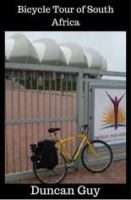
Photograph: A well-designed pathway
As Pretoria came into view, my friend Dave who was sitting beside me on the passenger seat, and who would take Muscle Cracker home to Jozi, suddenly confessed he’d never been to the Union Buildings.
I had, several times over the years as a reporter, the most memorable having been with his daughter who was job shadowing me for a grade ten school assignment.
Camilla’s eyes were wide open as we walked up the many steps to an office where a press conference was scheduled to be held.
Jackie Selebi, then already a troubled police chief, who has since been convicted of corruption, passed us.
“Any comment, commissioner?” I shot a quick question at him as he passed us on some steps.
“No comment,” he replied.
Then came the challenge of getting Camilla past the inches of bullet-proof glass at the security gate where one had to hand in one’s little green identity document.
“I’ve a student with me,” I explained to the official.
“Leave her ID document here.”
“She doesn’t yet have an ID book,” I explained.
“Then her driver’s licence,” replied the official.
“Err, no. She doesn’t have one either. She’s under age,” I said.
Fortunately the woman was quite co-operative.
“OK, then write down, here in the book, the name of the university she attends.”
I wrote down: Jeppe Girls’.
Jeppe Girls’ High School had long been known for its matric results with which its products proceeded to university, but it had never been upgraded to the status of a university! Not until that day at the Union Buildings!
COMMENT: What do think South Africa’s top cop getting into such trouble?
****
I had no set route to Hartbeespoort, more-or-less following the route of the inaugural Tour of South Africa; just the idea that I should head west on roads that were not freeways. Cyclists are not permitted to travel on them.
The road from the Union Buildings dropped down through immaculately-kept gardens, contained by the same stone as the grand buildings.
For a few streets I was in the land of apartment blocks on the edge of Pretoria’s city centre. Then, I crossed the Apies River and suddenly passed through a line of mini-bus taxis, all parked in “drive-away” position, ready to slip off, no doubt at speed, once they had filled up with passengers who needed to go to the far corners of Tshwane Municipality, in which Pretoria falls.
I imagined they had to stay and wait until knock-off time in the shops, offices and factories of South Africa’s administrative capital.
My passage through the taxis was uneventful, but things changed after I crossed a traffic light into a chaotic street full of pavement market stalls, blaring music and noisy hooters.
A taxi made an abrupt stop in front of me, prompting me to swerve left, whereupon I had to brake immediately to avoid running into passengers who were alighting after opening the vehicle’s sliding door.
When I recovered from that I veered back towards the middle lane of the road, only to be met by the passenger door of a little green sedan car opening after it, like the taxi, came to an abrupt halt. Only here, the passenger didn’t get out. He simply carried on chatting to the driver.
What a dangerous start to the beginning of more-or-less following the route of the inaugural Tour of South Africa!
I looked up at a building on the right where there was much activity: music, hawkers and pedestrians. A sign about it read “Bloed Street Mall”.
I was in Bloed, which means blood, Street.
I wondered whether a uniquely South African cycling competition shouldn’t include cyclists running such gauntlets.
COMMENT: Would it be a good idea to put international cycling stars to test in a South Africans street filled with taxis?
****
Once out of that chaos I took a detour through a neat little park where I intentionally rode through irrigation spray that watered a lawn. The place was a little oasis among shabby hawker stalls, many of them selling exhaust pipes and other spare parts.
In the park I noticed a number of concrete benches that were part of some sort of open air theatre. Then I saw a sign indicating that I was in “Marabastad Jazz Square”.
In the old days, Marabastad was a residential area in which people of different races lived alongside one another but when the apartheid laws kicked in, they were removed to racially-classified areas.
Heading west I hit a freeway – and a sign indicating that cyclists should not proceed further. I took a side road past an old age home where Pretoria aunties, or tannies as they are called in Afrikaans, which was probably their home language, sat in deck chairs.
A few turns later saw me on a road with a sign indicating it was the alternative route to Rustenburg for those not wanting to go along the toll road. Perfect! Any road between Pretoria and Rustenburg would be sure to pass Hartbeespoort.
I pedalled along a special concreted pedestrian route parallel to the Rustenburg road, always in the shade of young jacaranda trees that were planted at regular intervals.
There were also waist-high litter bins.
I gave a silent word of congratulations to the town planners of this walking/cycling route, which turned out to be between Pretoria West and Atteridgeville, a township that was established to house black African people forcibly moved from Marabastad.
COMMENT: Should there be more comfortable walkways for pedestrians?


